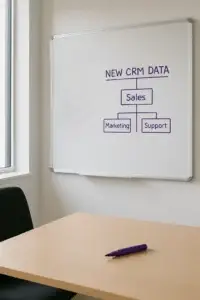Influencing the customer buying cycle – Saving you time and increasing your sales conversion rates with popcorn CRM
One of the fastest and simplest ways to save time and increase your sales conversion rates, is to focus on prospects that are already ready to buy. These prospects will be more engaged and in the place to say ‘Yes’ faster, than contacts who are still at the research stage of the buying cycle, or even worse, THOSE not even considering making a purchase.
Now I know you’re thinking that this is obvious and that the hard part is identifying the prospects that are ready to buy, but when you understand your customer’s buying process and how you can communicate with them at different stages, it’s actually quite easy.
They say that the best way to explain something is to tell a relatable story that demonstrates the point you are making, so here goes: This is the story of a broken TV and how much of the decision-making to buy a new one, is made at each stage…
The beginning – Awareness Stage (5% of Decision Made)
Let’s set the scene… Friday Nights are Movie Night in our house… as a Dad of 3 teenagers, it’s a lovely time to get together and argue over which movie we watch and who has got the most popcorn. At this point in our week, the TV is critical, and we often think that it would be nice if it was bigger, or had better picture quality; but in reality, we have a great TV that more than adequately does the job.
When I see promotional emails coming into my inbox, I’ll occasionally click on them to keep abreast of what is out there, but in reality, there is absolutely no sales opportunity or approval from my wife to upgrade.
A need arises – Research Stage (85% of Decision Made)
Let’s imagine that it’s a few weeks on and we’re all gathered and about to start the bickering/watch the latest Netflix offering. I flick the TV on, and the picture has a bit of a funny colour to it, which tells me that its days are numbered! So, after the kids have stopped moaning, I pick up my phone/laptop and start Googling TV’s. At this point I’m probably not sure how much I want to spend, the features I want or how big it’s going to be, so I start the research and very quickly filter my choices down to a handful of brands and models.
But if your house is anything like mine, there’ll be passionate arguments from the kids about what features we absolutely ‘NEED’ in the new TV, all of which has to be weighed up against a realistic budget, and approved by the wife. I was in no major rush to buy because the TV still worked, so in terms of the Buying Cycle, at no point during this stage of the process am I prepared to buy. Trying to sell to me now would only result in push backs and loads of time-wasting questions, whilst I get everything straight in my head.
Once I have my RESEARCH sorted and I’ve got it down to the final few models, my next step is to go and look at them, because features are one thing, but reality is often very different. So, off I trot to my local Currys (other electrical suppliers are available) with all 3 kids in tow (because they want to persuade me to get the bigger TV, a new PlayStation, a new Alexa and a…(insert gadget name here). So I walk through the store door and a friendly member of staff greets me with a smile and asks ‘is there anything I can help you with?’
Now, you’d think that since I was walking into the store with the intent to buy and have my influencers with me, I’d say ‘YES’ to this question. But, what do we all say in this situation, ‘No thanks, I’m just browsing’. And this is because I’m still in the research phase of the buying cycle. So I head over to the TV’s, poke, prod and scratch my head at the ones I’m considering. At this point, I probably have a few technical questions that need confirming, as I’ve made 85% of my buying decision and I’m ALMOST ready to commit…
Making the purchase – Intent Stage (95% of Decision Made)
I’ve now officially moved into the ‘Intent Stage’ of the customer buying cycle – this is the point that I reach out to a salesperson. The reason I’m comfortable to do this, is that I am now confident that I know what I am talking about (not going to look like a plonker, ask silly questions or get upsold). I know what is in my budget and my team are in agreement (well mostly, my son still wants a new PS5, but I’ve said no, and he is only a minor influence on the decision).
Now this seems a little unfair, as I’ve spent hours reading reviews, asked questions on competitor’s chat bots, brushed off offers of help from the smiley staff at the front door, and then I offer the nearest person to me the sale. But, the reason for this is that Currys had ensured that their reviews were at the top of the Search results, they had made their website really easy to find with everything I needed and even greeted me with a friendly smile when I came into the store, when they knew I was most likely to say no. All this Marketing had led me to the point where I knew that I could probably get the TV elsewhere for a few quid cheaper, but they had been in the right place, at the right time and they understood what I needed. So, I was happy to buy from them, and I am now the proud owner of a shiny new TV… (85 inches).
Post purchase – Remorse Stage (100% of Decision Made)
Roll forward a few days to the next movie night, we’re all sitting TOGETHER watching the movie and my son jokes about how much better it would be if we were watching it on a new PS5. Now, I know that it would not have made any real difference, but the thought does run through my head, and I think about being able to have his old console as MY Playstation. So from a purely research perspective, I jump onto Google to check out PS5 prices (for fun as we don’t have a magic money tree) and I spot that my TV is now £50 cheaper than when bought it!
Buyer remorse now kicks in. It’s not going to change anything, but it will leave that tiny nagging thought in my mind… ‘did I make the right decision…?’
This is the point that our communication with prospects needs to change. Just because I’ve purchased recently doesn’t mean I won’t buy again or buy something different, so in an ideal world, if Currys had sent me an email with their top tips to get the most out of my TV, I’d have lapped it up. And whilst I was back on their website reading about it, if there had been a deal for a PS5, I may have leaped at it and been upsold.
Applying this to your business
If you relate this to your customers and the journey they go though to buy your products / services, I’d be confident that they’d say that they go on exactly the same emotional journey that I did; and if you engage with them appropriately, it will save you loads of time and loads of money.
Here is a simple run through of how this translates to your customers’ buying journey, and some examples of the relevant Marketing tools that can be applied at each stage:
Awareness Stage
This is all about brand awareness – do not expect to sell to anyone at this stage, because in reality all you are doing is reminding them that you are there, what you offer and what your company values are.
Marketing Tools = Social Media, Email Marketing, YouTube, Large-scale Networking / Exhibitions and SEO.
Research Stage
This stage is all about knowledge sharing and establishing yourself as a trusted advisor/partner, but a smart business owner will also use the Marketing Tools they have to hand, to identify the intent signals. These are usually signs of increased engagement. When you do this, you can deliver relevant information to your prospects when they need it.
Marketing Tools = PPC, Automation Tools, Website Analytics, Email Marketing, Chat Bots, Referrals and Showrooms.
Intent Stage
This is where you should be focusing the majority of your time, money and effort on your prospects, as they are now comfortable to buy, so a more personal / targeted approach is needed to engage on a personal level.
Marketing Tools = Customer Services / Telesales, Targeted Messaging, Direct Mail, Automation and 121 Meetings
Remorse Stage
Reach out to your customer and make then feel good about the purchase they have just made, so when you start talking to them again you can identify cross-selling opportunities and turn them from being customers into advocates.
Marketing tools = Automation, Customer Service, Direct Mail.
So… how do you go about converting more prospects?
Now you know that the majority of the decision-making process is made during the research phase of the customer buying journey. When it comes to attempting to influence this stage, it is hard work, but extremely rewarding when you get it right, and my top tip is to be ‘honest!’ Now when I say honest, I really do mean HONEST! Don’t try to sell at this stage as your prospects can smell a sales pitch in seconds and when they do, you lose all the trust and confidence that you have worked so hard to develop. Think of ‘Which’, the online review company, people trust what they say, and so you should aim to become the ‘Which’ of your industry – tell it like it is, if your competitor has a better product/service, say it. But then tell them what you are the best at and why/when they should buy from you. You may lose a few leads initially, BUT because of the trust you have built, they are more likely to recommend you to one or more friends/colleagues, who might be a better match for you.
The next and most important step is to ensure that you have a process in place to identify when people are moving into the Intent stage.
Remember, people buy from people, so this is usually the stage where you should be investing time into nurturing the final questions your prospects have, as they are often the make-or-break questions, especially if you have a service that is not unique.
And finally… how do you save time? Well, implementing this process will generate you a lot more contacts/conversations/meetings etc… Ensuring that you and your team have a CRM that is simple to use, and you are all happy to use it, is also essential, because the easier everyone can put information into the CRM, the more likely it is that it will be used. And when you have a CRM that works for your small business, everyone and everything will be joined up and so you will never miss a sale or lose an opportunity.
A last bit of advice… don’t get caught in the ‘automation and software that does everything in one place’ trap. These tools are brilliant, but being very honest, to make them work properly, they require a lot of time and often money. Instead focus on building a simple process that works, then enhance it with automation or learn about the 3 software solution that replaces the likes of HubSpot, SalesForce, etc…
popcorn CRM is the small business alternative to HubSpot – join up your Email Marketing, Website tracking and CRM to tell you when and why your prospects are ready to buy.











